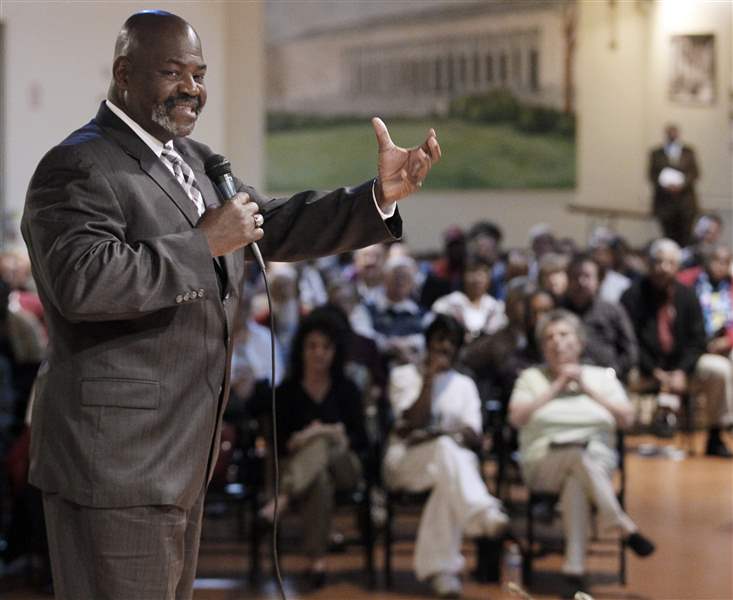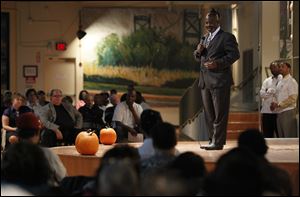
Toledo group seeks community assistance to reduce youth violence
10/5/2011
Mayor Mike Bell speaks during a meeting of the minds for the "Mayor's Coalition for Hope" Tuesday, 10/04/11, at the Erie Street Market in Toledo, Ohio.
The Blade/Jeremy Wadsworth
Buy This Image

Mayor Mike Bell speaks during a meeting of the minds for the "Mayor's Coalition for Hope" Tuesday, 10/04/11, at the Erie Street Market in Toledo, Ohio.
There isn’t a shortage of organizations in the quest to quell youth violence in Toledo. What can be challenging, however, is making sure all the legs are marching in the same direction.
After almost two months of weekly meetings and two excursions into high-risk neighborhoods, Mayor Mike Bell’s Coalition for Hope hosted a large gathering Tuesday at the Erie Street Market to ask community leaders and residents to come together in an effort to see how resources can be best connected and aligned.
The pitch was simple: Sign up under one of six categories you feel your qualifications and interests lean and say what you’re willing to do to help work toward a solution to the problem.
“There’s so many folks in this room doing good work, but we may not be connected to the next person,” said the Rev. John C. Jones, the president of the Greater Toledo Urban League and one of the coalition members who spoke.
Linda Alvarado, executive director of the city’s Board of Community Relations, said the prevalence of youth violence isn’t easily explained. It has roots in the economy, the community, and is permeated with social and cultural factors.
“We understand it’s such a complex issue,” she said.
But it’s a pressing one, a grim reality brought to the forefront by a rash of early summer shootings.

Mayor Mike Bell speaks during a meeting of the minds for the "Mayor's Coalition for Hope" Tuesday, 10/04/11, at the Erie Street Market in Toledo, Ohio.
“Folks in the community started saying enough is enough,” Rev. Jones said.
And leaders say they know from their survey of about 150 North Toledo and Old West End residents that people are ready to work together for change, but are hungry for the help to do it. Officials said more than half of those surveyed believe things like block watches and faith-based initiatives have made some difference. But as of yet, it’s not enough, as youth violence and gang violence remained the top two concerns in the survey. The top answers for what is needed to correct the path were jobs and job training, mentoring, and recreational opportunities.
“If we don’t put time into this and effort into this, we’re going to lose our city and lose our kids,” Mayor Bell said.
The mayor recalled seeing a group of youngsters playing football while on one of the previous walks. He was impressed, but questioned their coach why some schools have trouble finding enough students to fill their rosters. The answer, Mayor Bell said, was that in many cases their grades didn’t meet eligibility requirements. As one of the keys to keeping youth out of trouble is keeping them busy, he mulled aloud whether it might be possible to set up a study table before or after practices, similar to the way many college football programs do.
Coalition leaders have identified six categories or “pillars” to work toward correcting the problem: criminal justice, youth outreach, community mobilization, faith-based organizations, education, and economics.
The turnout was good, thanks in part to Ms. Alvarado’s networking. Since taking over her position, Ms. Alvarado has amassed a list of some 3,000 email addresses, a contact chain that helped bring in at least 200 people Tuesday who signed up to help. “We want to see what’s out there, what people are willing to do, and if there are gaps we need to address that as a city,” she said.
The coalition plans more ventures to the streets and leaders will soon begin calling those who signed up to set individual meetings. The results and suggestions of those will go back to the steering committee, which will craft an overall plan.